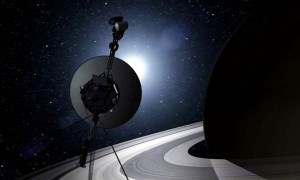
NASA‘s Voyager 1 spacecraft have now entered a new region between our solar system and interstellar space. The data obtained from Voyager over the last year reveals this new region to be a sort of cosmic purgatory. In this area the wind of charged particles streaming out from our sun has become calmer, our solar system’s magnetic field is piled up, and higher energy particles from inside our solar system appear to be leaking out into interstellar space.
Although Voyager 1 is about 18 billion kilometers (11 billion miles) from the sun, it is not yet in interstellar space. Based on the latest data collected, the direction of the magnetic field lines has not changed, indicating Voyager is still within the heliosphere, the bubble of charged particles the sun blows around itself. The data do not reveal exactly when Voyager 1 will make it past the edge of the solar atmosphere into interstellar space, but suggest it will be in a few months to a few years.
Both Voyager 1 and 2 were launched in 1977 and are still in good health. Voyager 1 is 18 billion kilometers (11 billion miles), and Voyager 2 respectively 15 billion kilometers (9 billion miles) away from the sun. The Voyager modules have been measuring energetic particles that originate from inside and outside our solar system. Until the middle of 2010, the intensity of particles originating from inside our solar system had been holding steady. During the past year though, the intensity of these energetic particles has been declining, as though they are leaking out into interstellar space. The particles are now half as abundant as they were during the previous five years.
During this past year, Voyager’s magnetometer also detected a doubling in the intensity of the magnetic field in the stagnation region. Like cars piling up at a clogged freeway off-ramp, the increased intensity of the magnetic field shows that inward pressure from interstellar space is compacting it. Scientists previously reported the outward speed of the solar wind had diminished to zero in April 2010, marking the start of the new region. Mission managers rolled the spacecraft several times this spring and summer to help scientists discern whether the solar wind was blowing strongly in another direction. It was not. Voyager 1 is plying the celestial seas in a region similar to Earth’s doldrums, where there is very little wind. It ia not clear when Voyager 1 will leave the heliosphere and enter a new region, previously never traveled, but it sure will be interesting to see what lays beyond the edge of our solar system.
